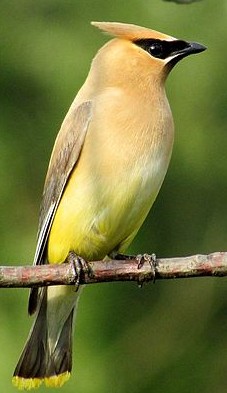 This small family consists of one genus that has two species found in North America, cedar waxwings, and Bohemian waxwings. The Bohemian waxwings nest in northern Canada and Alaska and appear in northern states during the winter. Cedar waxwings, on the other hand, are found in northern United States in the summer but all over the country in winter. Both kinds of waxwings are greyish brown on top with a paler breast and have a backward-pointing crest, a black mask, a brightly colored terminal tail band, and unique red tips on some of the wing feathers that look like sealing wax and give the birds their common name. Their legs are short and strong, their wings are pointed, and their bills are short and broad to facilitate a diet of fruits. Although primarily fruit eaters, waxwings also eat insects and in spring will eat sap, buds, and flowers. Waxwings are aboreal birds and enjoy a habitat with plenty of trees and shrubs.
This small family consists of one genus that has two species found in North America, cedar waxwings, and Bohemian waxwings. The Bohemian waxwings nest in northern Canada and Alaska and appear in northern states during the winter. Cedar waxwings, on the other hand, are found in northern United States in the summer but all over the country in winter. Both kinds of waxwings are greyish brown on top with a paler breast and have a backward-pointing crest, a black mask, a brightly colored terminal tail band, and unique red tips on some of the wing feathers that look like sealing wax and give the birds their common name. Their legs are short and strong, their wings are pointed, and their bills are short and broad to facilitate a diet of fruits. Although primarily fruit eaters, waxwings also eat insects and in spring will eat sap, buds, and flowers. Waxwings are aboreal birds and enjoy a habitat with plenty of trees and shrubs.
Waxwings are considered easy birds to attract to a backyard but will stay only as long as the food supply lasts. They are especially attracted by red berries and choosing plants that will produce and maintain a continuous crop from early summer through winter is the key to success.
Serviceberry (Amelanchier cultivars and hybrids)
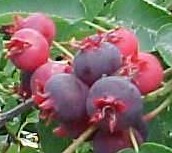 White flowers appear in early spring before the leaves on this deciduous shrub or small tree native to North America. In the fall blueberry like fruits follow the flowers and the leaves turn red, organge, and purple. Serviceberry is especially pleasing planted in a group and will provide fruit for waxwings as well as other berry eating birds such as orioles, tanagers, thrushes, and wrens. Warblers and vireos like the insects that are attracted to the flowers.
White flowers appear in early spring before the leaves on this deciduous shrub or small tree native to North America. In the fall blueberry like fruits follow the flowers and the leaves turn red, organge, and purple. Serviceberry is especially pleasing planted in a group and will provide fruit for waxwings as well as other berry eating birds such as orioles, tanagers, thrushes, and wrens. Warblers and vireos like the insects that are attracted to the flowers.
Size: 15-30′ depending on the variety
Site: Full sun to part shade; medium moist, well-drained soil
Hardiness: Zones 4-9 depending on the variety
Hawthorn (Crataegus spp. and cultivars)
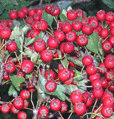 These small deciduous trees have thorny branches and produce a cloud of white flowers in spring followed by red berries in the fall. Waxwings enjoy the berries as well as the insects attracted by the flowers. The berries also attract thrushes and the insects around he flowers attract orioles, vireos, tanagers, warblers, and flycatchers. Robins and cardinals may use the plants for nest sites.
These small deciduous trees have thorny branches and produce a cloud of white flowers in spring followed by red berries in the fall. Waxwings enjoy the berries as well as the insects attracted by the flowers. The berries also attract thrushes and the insects around he flowers attract orioles, vireos, tanagers, warblers, and flycatchers. Robins and cardinals may use the plants for nest sites.
Size:To 20′ H
Site: Full sun; medium moist, well-drained soil
Hardiness: Zones 3-9
Sour Cherry (Prunus cerasus)
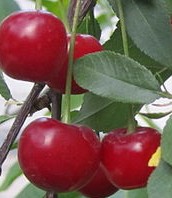 The cherries from these trees are used for pie making if you can pick them before the waxwings get them. Trees produce a showy display of white flowers in spring followed by red fruits in early summer. Trees are self pollinating but the biggest crop is obtained by planting more than one variety. Dwarf varieties are avaible for small spaces. In addition to waxwings, thrushes, orioles and many other birds eat the fruit; vireos, orioles, and warblers visit for the insects around the flowers.
The cherries from these trees are used for pie making if you can pick them before the waxwings get them. Trees produce a showy display of white flowers in spring followed by red fruits in early summer. Trees are self pollinating but the biggest crop is obtained by planting more than one variety. Dwarf varieties are avaible for small spaces. In addition to waxwings, thrushes, orioles and many other birds eat the fruit; vireos, orioles, and warblers visit for the insects around the flowers.
Size: Dwarf 12′ H ; nondwarf 30′ H
Site: Full sun; medium moist, well-drained soil
Hardiness: Zones 4-9
Sweet Cherry (Prunus avium)
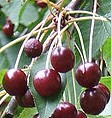 As indicated by the specific name, avium (meaning bird in Latin), sweet cherry is also known as “bird cherry” because it is so popular with our feathered friends when they ripen in early summer. The showy display of flowers in the spring is another plus. The fruits of sweet cherry are larger than those of sour cherry as well as being sweeter. They attract waxwings as well as other fruit lovers such as thrushes and orioles. Vieros, orioles, and warblers dine on the insects at the flowers and hummingbirds may nest in young trees. Dwarf trees are available.
As indicated by the specific name, avium (meaning bird in Latin), sweet cherry is also known as “bird cherry” because it is so popular with our feathered friends when they ripen in early summer. The showy display of flowers in the spring is another plus. The fruits of sweet cherry are larger than those of sour cherry as well as being sweeter. They attract waxwings as well as other fruit lovers such as thrushes and orioles. Vieros, orioles, and warblers dine on the insects at the flowers and hummingbirds may nest in young trees. Dwarf trees are available.
Size: Dwarf 12′ H; nondwarf 30′ H
Site: Full sun; medium moist, well-drained soil
Hardiness: Zones 5-8
Red Elderberry (Pacific, Sambucus callicarpa; eastern, S. pubens)
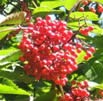 These deciduous shrubs are vigorous and fast growing reaching a lage size the first year. Clusters of fagrant, creamy white flowers in early summerare followed by small, juicy red berries in mid- to late summer. Waxwings enjoy the fruit along with wrens, trushes, and orioles. Warblres, vireos, orioles, kinglets, and flycatchers visit for the insects around the flowers. Use the species rather than fancy cultivars because they are more attractive to the birds.
These deciduous shrubs are vigorous and fast growing reaching a lage size the first year. Clusters of fagrant, creamy white flowers in early summerare followed by small, juicy red berries in mid- to late summer. Waxwings enjoy the fruit along with wrens, trushes, and orioles. Warblres, vireos, orioles, kinglets, and flycatchers visit for the insects around the flowers. Use the species rather than fancy cultivars because they are more attractive to the birds.
Size: 8′ H
Site: Full sun but tolerates part shade; medium moist soil
Hardiness: S. callicarpa zones 6-9; S. pubens zones 4-9
Mountain Ash ( Sorbus spp such as S. americana and S. aucuparia)
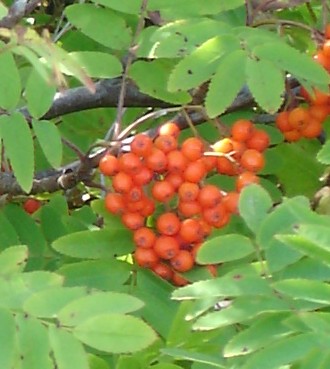 Several trees are known as mountain ash and all do best cool areas as they do not tolerate heat and humidity. They are small, fast growing,deciduous, open-branched trees with creamy flowers in spring followed by small orange, pink, red, or salmon berries in fall. Waxwings enjoy both the fruit and the insects attracted by the flowers. Thrushes, tanagers, orioles, and some flycatchers eat the fruit, vireos, warblers, flycatchers, tanagers and orioles enjoy the insects at the flowers.
Several trees are known as mountain ash and all do best cool areas as they do not tolerate heat and humidity. They are small, fast growing,deciduous, open-branched trees with creamy flowers in spring followed by small orange, pink, red, or salmon berries in fall. Waxwings enjoy both the fruit and the insects attracted by the flowers. Thrushes, tanagers, orioles, and some flycatchers eat the fruit, vireos, warblers, flycatchers, tanagers and orioles enjoy the insects at the flowers.
Size: About 20′
Site: Full sun; moist acidic soil
Hardiness: Zones 3-6/7 depending on the species.

r waxwing photo from Wikipedia